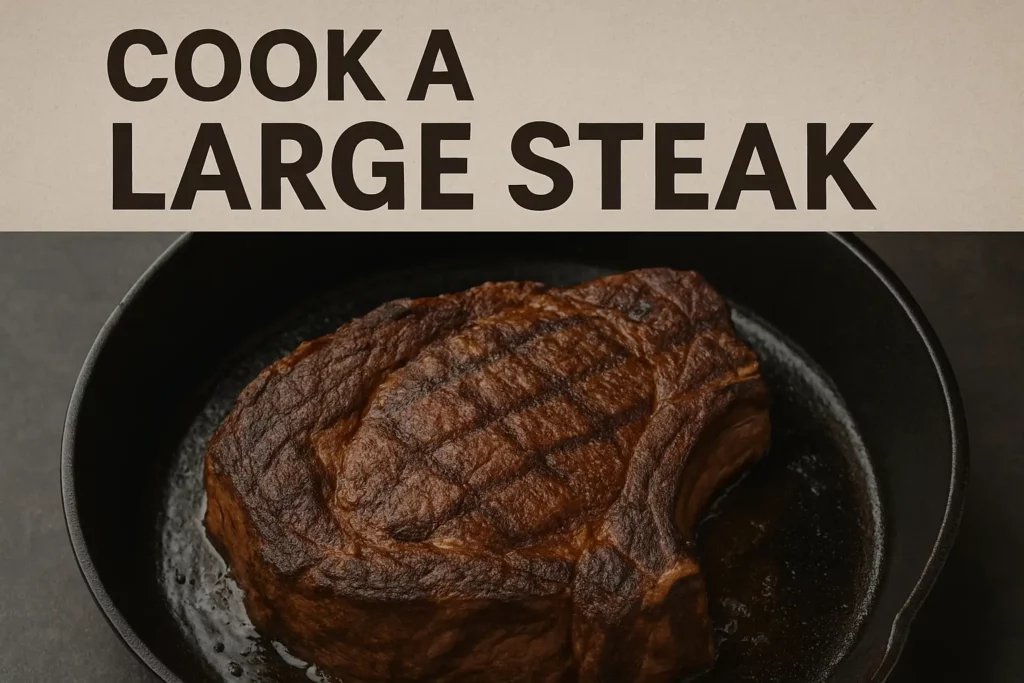This post may contain affiliate links. If you use these links to buy something we may earn a small commission. Thanks.
Few dishes make a statement quite like a large, perfectly cooked steak. Whether you’re preparing a tomahawk ribeye, a thick porterhouse, or a bone-in cowboy steak, learning how to cook a large steak is essential for any serious home cook or grill enthusiast. These impressive cuts are not just meals they’re an experience. However, they also come with challenges, like getting the interior to your desired doneness without burning the exterior or drying out the meat.
In this comprehensive guide, you’ll learn everything you need to know from choosing the right cut to mastering cooking techniques like reverse searing, pan-searing, and grilling. Ready to cook a steakhouse-quality large steak at home? Let’s dive in.
Introduction: Why Large Steaks Are Special
Large steaks are more than just food they’re the centerpiece of celebratory meals, cookouts, and Sunday feasts. Their thick, bone-in nature makes them ideal for locking in flavor and achieving a contrast between a seared exterior and a tender, juicy center. These steaks are:

- Highly marbled and rich in beefy flavor
- Impressive for presentation
- Perfect for sharing with others
Common large steak cuts include:
- Tomahawk Ribeye: Long bone handle, dramatic presentation
- Cowboy Ribeye: Similar to tomahawk, but shorter bone
- Porterhouse: Includes both strip and tenderloin
- T-Bone: Smaller version of porterhouse
Cooking these steaks right requires more than just a hot pan it’s an art form that combines temperature control, timing, and technique.
Choosing the Right Steak
A. Thickness Matters
A true “large steak” should be at least 1.5 to 3 inches thick. Thinner cuts will overcook before they sear properly.
B. Beef Grades
- Prime: Highest quality, abundant marbling best for flavor and texture.
- Choice: Still very good and more affordable.
- Select: Leaner, less flavorful not recommended for large steaks.
C. Bone-In vs Boneless
Bone-in steaks not only look impressive but also help the meat cook more evenly and retain moisture. The bone also imparts extra flavor during cooking.
D. Marbling
Look for visible white flecks of fat (marbling) throughout the steak this ensures juicy, flavorful results.
Preparing the Steak
A. Thawing
If frozen, thaw your steak completely before cooking:
- Refrigerator method: Place in the fridge for 24–48 hours.
- Cold water method: Submerge vacuum-sealed steak in cold water, changing water every 30 minutes until thawed.
B. Bring to Room Temperature
Let the steak sit at room temperature for 30–60 minutes. This promotes even cooking.
C. Pat Dry
Use paper towels to remove surface moisture. This ensures a good sear.
D. Seasoning
Simple Seasoning (Highly Recommended)
- Coarse kosher salt
- Freshly ground black pepper
- Optional: garlic powder or onion powder
Dry Rubs
Create a crust with dry spice mixes think smoked paprika, rosemary, chili powder, or espresso.
Marinades
Not necessary for high-quality steaks, but acidic marinades (with lemon, vinegar, or soy) can tenderize cheaper cuts. Do not marinate longer than 1–2 hours for large steaks.
Dry Brine (Optional)
Sprinkle salt generously on the steak 24 hours before cooking and leave it uncovered in the fridge. This enhances flavor and surface browning.
Cooking Methods for Large Steaks
A. Reverse Sear Method
This is the gold standard for large steaks. The reverse sear slowly brings the steak to temperature in the oven before finishing it with a hot sear for a perfect crust.
Steps:
- Preheat oven to 250°F (120°C).
- Place steak on a wire rack over a baking sheet.
- Cook until internal temp hits 10–15°F below your target (see temperature chart below).
- Rest steak for 10–15 minutes.
- Sear in a hot skillet with oil for 1–2 minutes per side.
Why It Works:
- Prevents overcooking
- Promotes even doneness edge-to-edge
- Develops a beautiful crust without burning
B. Pan-Searing with Oven Finish
Ideal for those who prefer stovetop simplicity with an oven backup.
Steps:
- Preheat oven to 400°F (204°C).
- Sear steak in a hot cast iron skillet with oil for 3–4 minutes per side.
- Transfer skillet to oven and roast until desired doneness.
- Rest for 10–15 minutes before slicing.
Equipment Tip:
Use a meat thermometer to track internal temperature throughout cooking.
C. Grilling a Large Steak
Perfect for summer or outdoor cooking lovers.
Two-Zone Grilling Method:
- Preheat grill with one hot and one cooler zone.
- Place steak on the cooler side with lid closed.
- Cook slowly until internal temp is 10–15°F shy of target.
- Move to hot side to sear for 2 minutes per side.
- Rest before serving.
Grill Tip:
Use a meat probe or instant-read thermometer for accuracy. Don’t flip too often—once per side is enough.
D. Sous Vide and Sear
Sous vide ensures edge-to-edge precision. While it takes more time, it guarantees the exact doneness.
Steps:
- Set sous vide bath to target temp (e.g., 130°F for medium-rare).
- Vacuum seal steak and place in water for 1.5–2.5 hours.
- Remove and dry steak thoroughly.
- Sear in a ripping hot skillet or with a torch.
Bonus:
Perfect for dinner parties or meal prepping, since steaks can sit in the sous vide until you’re ready.
Doneness Guide and Internal Temperatures
| Doneness | Description | Internal Temp | Pull Temp (before searing/resting) |
|---|---|---|---|
| Rare | Cool red center | 120°F (49°C) | 110–115°F |
| Medium-Rare | Warm red center | 130°F (54°C) | 115–120°F |
| Medium | Warm pink center | 140°F (60°C) | 125–130°F |
| Medium-Well | Slightly pink | 150°F (66°C) | 135–140°F |
| Well-Done | Fully cooked | 160°F (71°C)+ | 145–150°F+ |
Use an instant-read digital thermometer. Accuracy is crucial for large steaks.
Resting and Slicing the Steak
Why Resting Matters
After cooking, juices need time to redistribute throughout the meat. Cutting too early will cause juices to run out and dry the steak.
- Rest time: 10–15 minutes, tented loosely with foil
Slicing Tips
- Slice against the grain for tenderness
- Use a sharp chef’s knife
- For bone-in steaks, slice around the bone first, then cut individual pieces
Serving Ideas and Pairings
Toppings & Sauces
- Garlic herb butter (compound butter)
- Chimichurri
- Peppercorn cream sauce
- Blue cheese crumbles
Side Dishes
- Grilled asparagus or broccolini
- Roasted garlic mashed potatoes
- Creamed spinach
- Crusty sourdough bread
Wine Pairings
- Cabernet Sauvignon: Bold and dry, perfect for ribeye
- Malbec: Fruity with a smoky finish
- Syrah/Shiraz: Peppery notes complement charred crust
Common Mistakes to Avoid
- Overcooking: Always track internal temperature
- No thermometer: Cooking blind leads to dry steak
- Skipping the rest: Resting ensures juicy meat
- Using cold steak: Causes uneven cooking
- Not drying steak: Results in steamed, not seared, surface
- Too much flipping: Reduces crust development
Sample Recipe: Reverse-Sear Tomahawk Ribeye
Ingredients
- 1 large tomahawk steak (2–2.5 inches thick)
- 1 tbsp kosher salt
- 1 tsp black pepper
- 1 tbsp avocado oil or canola oil
- 2 cloves garlic, crushed
- 2 sprigs rosemary or thyme
- Optional: butter for basting
Instructions
- Preheat oven to 250°F.
- Season steak generously with salt and pepper.
- Place on wire rack over baking sheet and roast for 30–45 mins until 115°F internal temp.
- Rest steak for 10 minutes.
- Heat skillet with oil on high heat until just smoking.
- Add steak, garlic, and herbs. Sear 1–2 minutes per side.
- Optional: Add butter and baste during last 30 seconds.
- Rest again for 5 minutes. Slice and serve with sides.
FAQs
Can I cook a large steak from frozen?
It’s possible but not ideal. If you must, use a reverse sear method starting in a low oven, but cooking time will increase substantially.
What oil should I use for searing?
Use oils with high smoke points such as avocado oil, canola, or grapeseed oil.
How do I reheat leftover steak without drying it out?
Wrap in foil and reheat in a low oven (250°F) for 10–15 minutes. Finish with a quick sear if needed.
Do I need to trim the fat?
No fat adds flavor and moisture. Trim after cooking if needed.
Conclusion
Cooking a large steak to perfection is a skill that combines patience, temperature control, and an understanding of how meat behaves under heat. Whether you’re grilling a porterhouse, pan-searing a cowboy ribeye, or reverse-searing a tomahawk, this guide ensures you do it with confidence.
Remember: Season generously, cook gently, sear hot, and rest well. Master those four principles, and every steak night will feel like a celebration.
